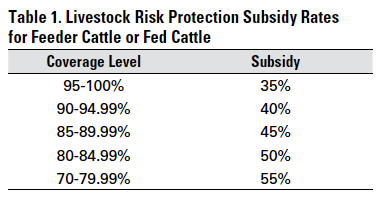Understanding Animals Danger Security (LRP) Insurance: A Comprehensive Guide
Navigating the realm of livestock threat defense (LRP) insurance policy can be a complicated venture for lots of in the agricultural market. From just how LRP insurance coverage functions to the various protection options available, there is much to reveal in this comprehensive guide that can potentially form the means livestock producers approach threat management in their services.

Just How LRP Insurance Coverage Functions
Periodically, recognizing the technicians of Animals Risk Protection (LRP) insurance policy can be intricate, yet damaging down exactly how it functions can give quality for farmers and herdsmans. LRP insurance is a risk management device made to safeguard livestock manufacturers against unexpected price decreases. The policy allows manufacturers to establish a coverage level based on their specific demands, picking the variety of head, weight array, and coverage price. Once the policy remains in place, if market prices drop below the coverage price, manufacturers can submit a case for the distinction. It is very important to keep in mind that LRP insurance is not an income assurance; instead, it focuses exclusively on cost danger security. The protection period usually ranges from 13 to 52 weeks, giving flexibility for producers to select a duration that lines up with their production cycle. By using LRP insurance, farmers and breeders can mitigate the monetary threats connected with changing market prices, ensuring better security in their procedures.
Eligibility and Insurance Coverage Options

When it concerns insurance coverage choices, LRP insurance offers producers the adaptability to select the insurance coverage level, coverage duration, and endorsements that finest match their threat administration demands. Protection degrees generally range from 70% to 100% of the expected ending value of the insured animals. Producers can also choose insurance coverage durations that straighten with their production cycle, whether they are insuring feeder livestock, fed cattle, swine, or lamb. Endorsements such as rate risk security can even more tailor coverage to secure against unfavorable market fluctuations. By recognizing the qualification standards and protection options readily available, livestock producers can make enlightened choices to manage risk efficiently.
Advantages And Disadvantages of LRP Insurance
When assessing Animals Danger Protection (LRP) insurance coverage, it is crucial for livestock manufacturers to weigh the drawbacks and benefits integral in this danger monitoring device.

Among the key advantages of LRP insurance coverage is its capability to give security versus a decrease in animals costs. This can aid secure manufacturers from monetary losses resulting from market variations. In addition, LRP insurance policy uses a level of versatility, allowing manufacturers to customize protection degrees and policy durations to match their specific needs. By locking in an assured price for their livestock, manufacturers can much better take care of risk and plan for the future.
One restriction of LRP insurance policy is that it does not safeguard against all kinds of threats, such as illness outbreaks or natural catastrophes. It is crucial for producers to thoroughly assess their individual risk exposure and financial situation to figure out if LRP insurance policy is the right threat administration tool for their operation.
Recognizing LRP Insurance Premiums

Tips for Maximizing LRP Perks
Maximizing the advantages of Animals Risk Protection (LRP) insurance requires strategic planning and proactive risk monitoring - Bagley Risk Management. To take advantage of your LRP protection, think about the following suggestions:
On A Regular Basis Evaluate Market Conditions: Keep educated regarding market patterns and price changes in the livestock market. By keeping track of these variables, you can make informed decisions about when to purchase LRP protection to protect against potential losses.
Set Realistic Insurance Coverage Degrees: When choosing protection degrees, consider your manufacturing expenses, market price of livestock, and potential risks - Bagley Risk Management. Setting reasonable protection degrees makes sure that you are properly protected without paying too much for unneeded insurance coverage
Diversify Your Coverage: Rather than depending only on LRP insurance coverage, think about expanding your threat management techniques. Combining LRP with various other danger administration try these out tools such as futures contracts or options can supply extensive coverage against market unpredictabilities.
Review and Adjust Coverage On a regular basis: As market conditions alter, periodically examine your LRP protection to guarantee it lines up with your existing danger direct exposure. Readjusting coverage degrees and timing of purchases can assist optimize your danger defense approach. By complying with these pointers, you can optimize the benefits of LRP insurance coverage and guard your livestock operation versus unexpected dangers.
Final Thought
To conclude, livestock risk security (LRP) insurance policy is a useful device for farmers to handle the economic risks connected with their animals procedures. By understanding how LRP works, eligibility and protection choices, in addition to the advantages and disadvantages of this insurance coverage, farmers can make educated choices to shield their livelihoods. By thoroughly taking into consideration LRP premiums and executing techniques to maximize advantages, farmers can mitigate possible losses and ensure the sustainability of their procedures.
Animals producers interested in obtaining Animals Danger Security (LRP) insurance coverage can discover a range of qualification requirements and insurance coverage alternatives customized to their certain animals procedures.When it comes to protection alternatives, LRP insurance offers manufacturers the adaptability to select the protection level, insurance coverage period, and endorsements that best fit their danger management demands.To understand the details of Animals Risk Security (LRP) insurance fully, comprehending the variables affecting LRP insurance coverage costs is important. LRP insurance costs are figured out by numerous aspects, consisting of the resource insurance coverage level chosen, the expected rate of animals at the end of the coverage period, the type of animals being guaranteed, and the length of the protection period.Review and Adjust Coverage Routinely: As market conditions change, periodically evaluate your LRP insurance coverage to guarantee it straightens with your present threat direct exposure.